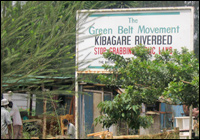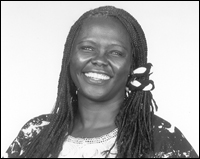
Wangari Maathai with good reason
to smile.
Photo: Goldman Environmental Prize.
It is a small room for such a momentous decision. And it’s made even smaller by the impressive portraits of past winners lining the walls, listening in on the secret deliberations of the Nobel Peace Prize committee.
Amidst the daily drumbeat of war stories, the committee hatched a wonderful surprise in that small third-story room. Today, they announced that Wangari Maathai, the Kenyan environmental activist and biologist-turned-deputy environment minister, will receive the world’s most prestigious award — the first time the Peace Prize has been awarded to honor work in the environmental field. Maathai will now receive the wide recognition she deserves for fighting to protect Kenya’s forests from corruption and degradation.
In 1977, Maathai founded the Green Belt Movement, which planted 30 million trees across the country, in the process employing thousands of women and offering them empowerment, education, and even family planning.

A Green Belt Movement outpost.
Photo: Geoffrey Dabelko.
GBM was grounded in the firm belief that environmental protection is inextricably linked to improving human living conditions. As Maathai told the UNESCO Courier in 1999, “If you want to save the environment, you should protect the people first, because human beings are part of biological diversity. And if we can’t protect our own species, what’s the point of protecting tree species?”
This grassroots movement had a broader impact than more traditional “environmental” movements. GBM focused on empowerment through the environment, which led Maathai to clash with Kenya’s ruling elites.
During Daniel arap Moi’s decades-long rule, the fight for environmental protection and democracy was not always easy. Maathai’s demonstrations to protect the forests often met violent resistance. Upon being jailed by a government intent on defending corruption and mismanagement, she proclaimed, “The government thinks that by threatening me and bashing me they can silence me. But I have an elephant’s skin and somebody must raise their voice.”
Wangari raised her voice higher in 1997 by running for president on the Liberal Party of Kenya ticket. In 2002 — after Moi’s Kenya Africa National Union party lost the presidential race — she was elected to Parliament, and the next year was appointed deputy minister of environment for the new government.
Green Peace
Awarding the Nobel Peace Prize to an environmental activist may raise some eyebrows. But Maathai is on the front lines of the struggle over natural resources that fuels conflicts across the world. While there is no dramatic footage of tanks rumbling across borders or airplanes flying into buildings, the everyday fight for survival of those who depend directly on natural resources — forests, water, minerals — for their livelihoods is at the heart of the battle for peace and human security. Maathai told Norway’s TV2, “When natural resources get scarce, wars are started. If we improve the management of our natural resources, we help promote peace.”

Maathai receiving the Goldman
Environmental Prize in 1991.
Photo: Goldman Environmental Prize.
“Peace on earth depends on our ability to secure our living environment,” said the Norwegian Nobel Committee. “Maathai stands at the front of the fight to promote ecologically viable social, economic, and cultural development in Kenya and in Africa.” The committee chair said Maathai “represents an example and a source of inspiration for everyone in Africa fighting for sustainable development, democracy, and peace.”
Those focusing on today’s hard security agenda of war and terrorism praise the award, too. Former Rep. Lee Hamilton (D-Ind.), president of the Woodrow Wilson International Center for Scholars and vice chair of the 9/11 Commission, said, “Today we face a range of difficult security challenges across the globe. The Nobel Committee has done a great service in highlighting the struggles for sustainable development, democracy, and peace that affect the safety and quality of life of literally billions of people every day.”
The committee chose well to add another picture to its hallowed walls, one of a woman from the Global South fighting for peace in the trenches, from the small villages of Kenya’s heartland to the crowded streets of Nairobi. Much of the debate about the link between environment and security plays out in the rarified air of Northern universities and think tanks (including my own) — even as they issue reams of paper about a South they only visit for conferences. Elevating such a strong Southern voice — and one whose elephant’s skin bears the scars of the fight for peace — is a noble choice.


